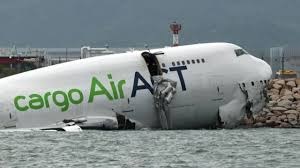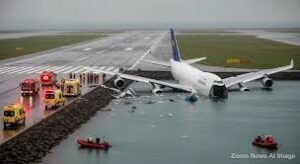HONG KONG, October 20, 2025 – Tragedy struck at Hong Kong International Airport (HKIA) early Monday morning as a major cargo aircraft skidded off the runway upon arrival, resulting in the deaths of two airport personnel. The incident, which occurred around 3:50 a.m. local time, has temporarily halted operations on one of the airport’s key flight paths and initiated a large-scale emergency response.
Local police confirmed the fatal accident, stating that four crew members aboard the aircraft were successfully rescued from the wreckage. However, the collision claimed the lives of two individuals believed to be airport staff who were not on the plane but were operating a ground vehicle—specifically, a fuel tanker truck.

The Sequence of Events
According to the Airport Authority, the cargo plane, which was operating a flight for Emirates and had originated from Dubai, overshot the runway upon landing and plunged into the sea.
Police suspect the aircraft collided with the fuel tanker truck as it veered off the paved surface. The vehicle, along with its occupants, was dragged off the runway at the same moment the aircraft failed to stop, suggesting a catastrophic interaction between the out-of-control jet and the ground support vehicle.
The two fatalities were the individuals inside the fuel truck, which was found near the stricken aircraft. Authorities have launched a full investigation to determine the precise chain of events that led to the jet’s failure to maintain the runway centerline and its subsequent impact with the ground vehicle.
Aircraft Details and Operational Impact
Preliminary tracking data from the flight safety website FlightRadar24 provided some insight into the moments leading up to the crash. The data, based on ADS-B transmission, indicated that the Boeing 747 was moving at a speed of approximately 90 kilometers per hour (about 56 mph) at the moment it contacted the water.
FlightRadar24 also clarified the ownership of the aircraft via its social media channels (X), noting that while the jet was carrying cargo for Emirates, it actually belonged to AirACT, a Turkish-based airline that often provides additional cargo capacity and charter services for larger carriers.
The Hong Kong Airport Authority (AA) immediately activated the Airport Emergency Centre and deployed full rescue operations following the incident. As a direct consequence of the crash and the ongoing recovery and investigation work, the North Runway (07L/25R) has been temporarily closed. Officials stated that the South Runway and the Center runway would remain operational, mitigating the full impact on one of the world’s busiest cargo and passenger hubs, though inevitable delays are anticipated.
Industry Response and Historical Context

As of the latest reports, the airline Emirates has yet to release an official statement regarding the accident involving the chartered flight. The focus for all involved parties remains the investigation and the recovery of the aircraft and the debris.
This tragic event is a stark reminder of the inherent risks in aviation, particularly concerning incidents involving runway excursions. While extremely rare, the consequences can be devastating, especially when ground vehicles and personnel are involved.
The incident is the deadliest at HKIA since a major accident in 1999. In that year, three people were killed when a China Airlines flight crashed upon landing during a severe storm. The plane flipped over on the tarmac at the then newly-opened international airport, highlighting the constant challenges of ensuring safety at high-traffic global airports.
The investigation will now be a complex, multi-agency effort, likely involving experts from Hong Kong, China, the United Arab Emirates (Emirates’ base), and Turkey (AirACT’s base), focusing on all factors: pilot action, mechanical failure, weather conditions, and ground operational protocols. The findings will be crucial for reinforcing safety procedures to prevent similar runway incursions that lead to collisions with vital ground support equipment.





